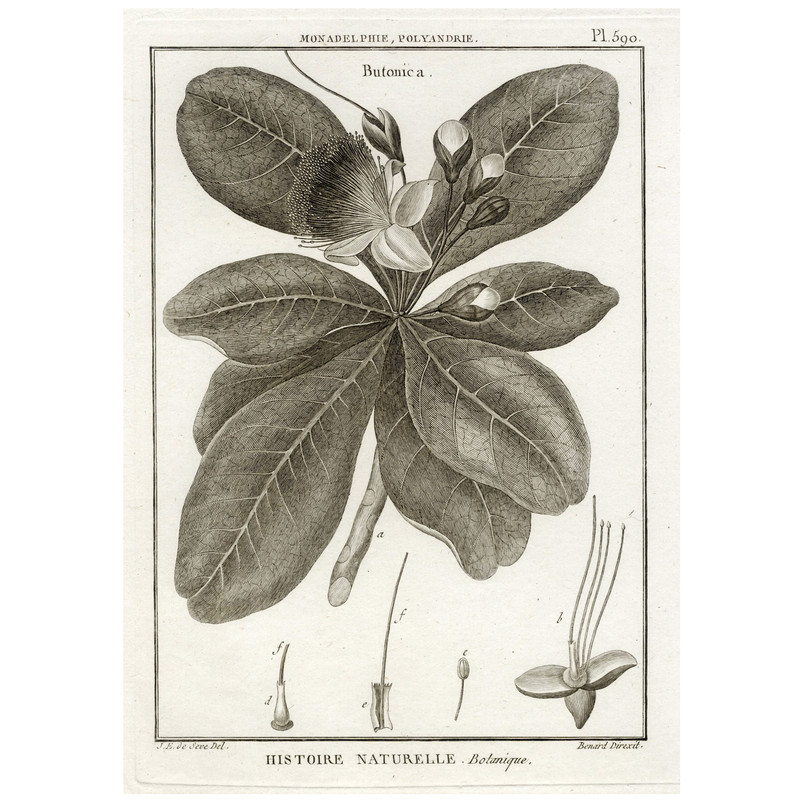1790 Scarce Large Copperplate Engravings from the Botanique volume of the Encyclopédie Méthodique:
TABLEAU
ENCYCLOPÉDIQUE
ET MÉTHODIQUE
DES TROIS RÈGNES DE LA NATURE.
HISTOIRE NATURELLE,
BOTANIQUE.
PAR M. LE CHAVALIER DE LA MARK
Plate 590, Butonica
(Barringtonia)

This rare, superb Botanical engraving originates from the Charles-Joseph Panckoucke's Encyclopédie Méthodique.
The Tableau encyclopédique et méthodique des trois règnes de la nature were the Natural History plate-volumes from Charles-Joseph Panckoucke's Encyclopédie Méthodique of Encyclopédie ou Dictionnaire raisonné by Diderot. (Eng: 'Encyclopedic and Methodical Table of the Three Reigns of Nature').
This one shows the Barringtonia, meticulously engraved in copper & hand-printed on handmade paper. These prints are treasures.
The Volumes:
The Encyclopédie méthodique par ordre des matières (lit. 'Methodical Encyclopedia by Order of Subject Matter') was published between 1782 and 1832 by the French publisher Charles Joseph Panckoucke, his son-in-law Henri Agasse, and the latter's wife, Thérèse-Charlotte Agasse. Arranged by disciplines, it was a revised and much expanded version, in roughly 210 to 216 volumes (different sets were bound differently), of the alphabetically arranged Encyclopédie, edited by Denis Diderot and Jean leRond d'Alembert. The full title was L'Encyclopédie méthodique ou par ordre de matières par une société de gens de lettres, de savants et d'artistes; précédée d'un vocabulaire universel, servant de table pour tout l'ouvrage, ornée des portraits de MM. Diderot et d'Alembert, premiers éditeurs de l'Encyclopédie.
In about fifty years (1782-1832), more than 200 volumes appeared (159 of text and 47 of plates) containing nearly 100,000 articles. The bookseller-publisher Clément Plomteux, established in Liège, assisted Panckoucke between 1782 and 1789. Upon Panckoucke's death, his son-in-law Henri Agasse and then his daughter Antoinette Pauline Agasse succeeded him.
Between 1783 and 1792 Lamarck published three large botanical volumes (text and plates). I believe this plat is from that set.
The Artist & Engraver:
These are signed by famed natural history illustrator Jacques de Sève (1742–1788) & engraver Jacques Renaud Benard (13 April 1731 – 4 July 1794).
De Sève was commissioned by Georges-Louis Leclerc, Comte de Buffon to provide the quadruped illustrations for Histoire naturelle, générale et particulière (1749-1778, in 36 volumes) and then Buffon's Recueil de Vingtquatre Plantes et Fleurs (1772). He also illustrated work by Duhamel du Monceau, Claude Perrault and parts of Encyclopédie Méthodique (the present work). His illustrations are sometimes exact anatomical representations or show the animals against landscape backgrounds.
Benard is mainly famous for having supplied a significant amount of plates (at least 1,800) to the Encyclopédie by Diderot & d'Alembert from 1751. Later, publisher Charles-Joseph Panckoucke reused many of his productions to illustrate the works of his catalog. Biographical research established in 2019 that his real name was Jacques Renaud Benard, that he was born in 1731 at Rosny-sous-Bois, and that he died in Paris in 1794. The signature "Benard fecit" on plates probably indicates the work of his own hand; the signatures "Benard Direx" and "Benard Direxit" indicate the work of the atelier of engravers he directed for many years.
The Author:
Jean-Baptiste Pierre Antoine de Monet, chevalier de Lamarck (1 August 1744 – 18 December 1829), often known simply as Lamarck was a French naturalist, biologist, academic, and soldier. He was an early proponent of the idea that biological evolution occurred and proceeded in accordance with natural laws.
The Plates & Technique:
Line-engraving or Copperplate engraving is a highly exacting & labor-intensive process for intaglio printmaking. The original drawing is cut into the surface of a copper or steel plate with a hand-held sharp steel point or burin, with shading created by many fine cut lines, or hatching. Before printing takes place, the plate is heated, covered with ink. The warm ink seeps into the finest of depressions and fills the lines and textures of the drawing. The rest of the plate is cleaned off. The copper plate is now pressed with a printing press on to moistened paper which soaks up the ink from the depressions in the plate. The copperplate-engraving technique is very exacting, time-consuming and exhausting for the engraver, who needs a lot of strength for it.
Every part of these prints was made by hand: Hand drawn & engraved on Copper or steel which was hand-mined, smelted & rolled, printed onto handmade cotton rag paper, inked & colored with hand-ground pigments individually by hand, & they were usually hand sewn into handmade leather-bound books.
Condition:
Excellent condition for a centuries-old engaving. Typical minor antiquarian character, Very little age-toning. These are apparently un-trimmed, since they still have a deckeled edge.
These prints are very old & may have minor imperfections expected with age, such as some typical age-toning of the paper, oxidation of the old original watercolors, spots, text-offsetting, artifacts from having been bound into a book & handled, etc. Please examine the photos & details carefully.
Text Page(s): This one comes without original text pages which were likely published in their own volumes. Included in the photos is a scan of a title page, which is for reference & not part of the listing.
Size: 12"x 9" approximately.








